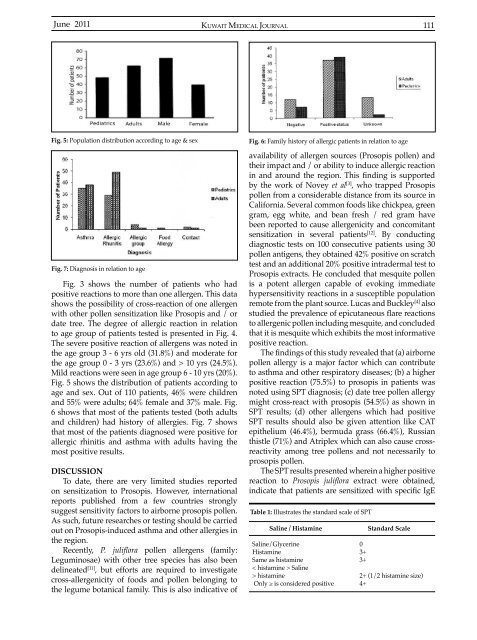Vol 43 # 2 June 2011 - Kma.org.kw
Vol 43 # 2 June 2011 - Kma.org.kw
Vol 43 # 2 June 2011 - Kma.org.kw
You also want an ePaper? Increase the reach of your titles
YUMPU automatically turns print PDFs into web optimized ePapers that Google loves.
<strong>June</strong> <strong>2011</strong><br />
KUWAIT MEDICAL JOURNAL 111<br />
Fig. 5: Population distribution according to age & sex<br />
Fig. 7: Diagnosis in relation to age<br />
Fig. 3 shows the number of patients who had<br />
positive reactions to more than one allergen. This data<br />
shows the possibility of cross-reaction of one allergen<br />
with other pollen sensitization like Prosopis and / or<br />
date tree. The degree of allergic reaction in relation<br />
to age group of patients tested is presented in Fig. 4.<br />
The severe positive reaction of allergens was noted in<br />
the age group 3 - 6 yrs old (31.8%) and moderate for<br />
the age group 0 - 3 yrs (23.6%) and > 10 yrs (24.5%).<br />
Mild reactions were seen in age group 6 - 10 yrs (20%).<br />
Fig. 5 shows the distribution of patients according to<br />
age and sex. Out of 110 patients, 46% were children<br />
and 55% were adults; 64% female and 37% male. Fig.<br />
6 shows that most of the patients tested (both adults<br />
and children) had history of allergies. Fig. 7 shows<br />
that most of the patients diagnosed were positive for<br />
allergic rhinitis and asthma with adults having the<br />
most positive results.<br />
DISCUSSION<br />
To date, there are very limited studies reported<br />
on sensitization to Prosopis. However, international<br />
reports published from a few countries strongly<br />
suggest sensitivity factors to airborne prosopis pollen.<br />
As such, future researches or testing should be carried<br />
out on Prosopis-induced asthma and other allergies in<br />
the region.<br />
Recently, P. juliflora pollen allergens (family:<br />
Leguminosae) with other tree species has also been<br />
delineated [11] , but efforts are required to investigate<br />
cross-allergenicity of foods and pollen belonging to<br />
the legume botanical family. This is also indicative of<br />
Fig. 6: Family history of allergic patients in relation to age<br />
availability of allergen sources (Prosopis pollen) and<br />
their impact and / or ability to induce allergic reaction<br />
in and around the region. This finding is supported<br />
by the work of Novey et al [3] , who trapped Prosopis<br />
pollen from a considerable distance from its source in<br />
California. Several common foods like chickpea, green<br />
gram, egg white, and bean fresh / red gram have<br />
been reported to cause allergenicity and concomitant<br />
sensitization in several patients [12] . By conducting<br />
diagnostic tests on 100 consecutive patients using 30<br />
pollen antigens, they obtained 42% positive on scratch<br />
test and an additional 20% positive intradermal test to<br />
Prosopis extracts. He concluded that mesquite pollen<br />
is a potent allergen capable of evoking immediate<br />
hypersensitivity reactions in a susceptible population<br />
remote from the plant source. Lucas and Buckley [4] also<br />
studied the prevalence of epicutaneous flare reactions<br />
to allergenic pollen including mesquite, and concluded<br />
that it is mesquite which exhibits the most informative<br />
positive reaction.<br />
The findings of this study revealed that (a) airborne<br />
pollen allergy is a major factor which can contribute<br />
to asthma and other respiratory diseases; (b) a higher<br />
positive reaction (75.5%) to prosopis in patients was<br />
noted using SPT diagnosis; (c) date tree pollen allergy<br />
might cross-react with prosopis (54.5%) as shown in<br />
SPT results; (d) other allergens which had positive<br />
SPT results should also be given attention like CAT<br />
epithelium (46.4%), bermuda grass (66.4%), Russian<br />
thistle (71%) and Atriplex which can also cause crossreactivity<br />
among tree pollens and not necessarily to<br />
prosopis pollen.<br />
The SPT results presented wherein a higher positive<br />
reaction to Prosopis juliflora extract were obtained,<br />
indicate that patients are sensitized with specific IgE<br />
Table 1: Illustrates the standard scale of SPT<br />
Saline / Histamine<br />
Saline/Glycerine<br />
Histamine<br />
Same as histamine<br />
< histamine > Saline<br />
> histamine<br />
Only ≥ is considered positive<br />
0<br />
3+<br />
3+<br />
Standard Scale<br />
2+ (1/2 histamine size)<br />
4+
















